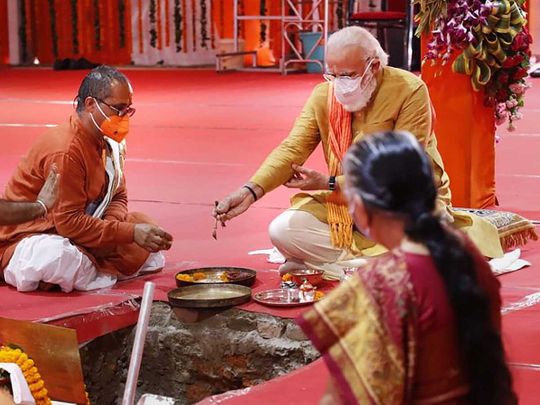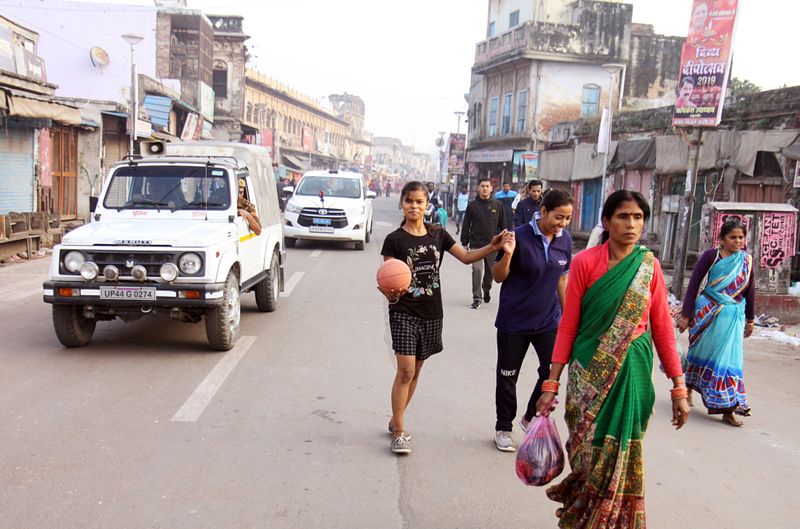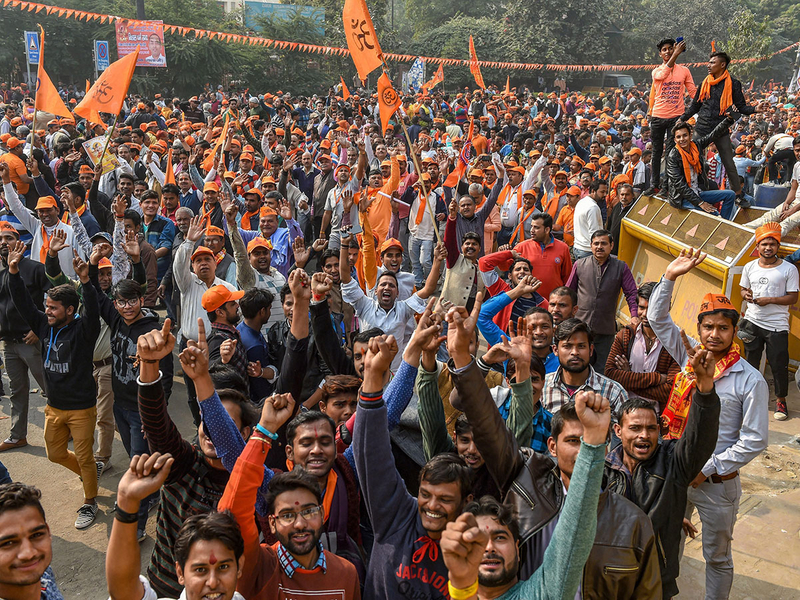
A 31-year wait is finally coming to an end today in India. And when India’s ruling Bharatiya Janata Party (BJP) stalwart and Prime Minister Narendra Modi lays that 22.6-kg silver brick, marking the groundbreaking ceremony for the construction of a new Ram Temple in Ayodhya, in the state of Uttar Pradesh (UP), it will probably be the single-biggest marker of emancipation of a nationalist Hindu identity in a country that constitutionally still remains secular.
The Supreme Court verdict last year, clearing the decks for the construction of a Ram Temple at the 2.77 acre disputed site in Ayodhya, that was also home to the iconic Babri Masjid, until its desecration and destruction on December 6, 1992, marked the culmination of a process that had actually been set rolling by former prime minister Rajiv Gandhi.
In 1985, the Rajiv-led Congress government at the Centre had taken two crucial decisions. First was over the issue of the practice of alimony in the Shah Bano case, in which Rajiv went against the apex court’s decision that repudiated Shah Bano was entitled to alimony from her husband. This was followed by the then prime minister’s one of the most controversial decisions and that was to open the locks to the Ramjanmabhhoomi-Babri Masjid site.
Opening the locks to disputed shrine
While no one had hardly offered any namaz (prayer) at the masjid for ages, a priest would perform religious rites at the temple only once a year. By ordering the opening of the locks to the disputed site, the Rajiv-led government had blatantly pandered to Hindu fundamentalist and rightist sentiments, just as it had sought to appease Muslim zealots by enacting a law to abolish the provision of alimony in the community.
How well a new India identifies itself with that machismo and what meaning it makes of it will be the thread to follow in the days ahead. Whether for the common man it will be a question of “So What” or “What Next” only time will tell
As luck would have it, Rajiv’s decisions backfired. In the 1989 general elections, Congress was voted out of power, with a major chunk of the Muslim vote siding with the new secular formation under V.P. Singh’s Janata Dal and the rise of Hindu fundamentalist sentiments in the Cow Belt (northern India) finding its most potent receptacle in post-independent India in the form of the BJP.
The dice cast by Rajiv was the surest and most definitive invocation to religious fundamentalism and appeasement of a majoritarian sentiment in India’s socio-political history, the full import of which will be felt today with the groundbreaking ceremony at Ayodhya.
Rajiv’s invocation to a cultural hubris and political nihilism have by default landed the saffron brigade, namely the BJP, a windfall! It was Rajiv’s call to play the Hindu fundamentalist card, but the political capital that he had invested only helped the BJP reap electoral dividends. Since the opening of the locks to the disputed site, the demolition of the Babri and the consequent communal riots across India helped the BJP build its own vote bank.

Electoral success story
Starting with BJP doyen Lal Krishna Advani’s infamous Rathyatra (chariot ride) in October 1990 to the Supreme Court verdict on the disputed site last year, what the BJP leadership has done very astutely is to try and coalesce the fundamentalist sentiments surrounding a Hindu nationalist agenda and convert that coalition of sentiments into an electoral success story.
This is where Hindu nationalist outfits such as Vishwa Hindu Parishad (VHP), Bajrang Dal and the Rashtriya Swayamsevak Sangh (RSS) have played a key role. By acting as interlocutors for Hindu fundamentalism and by championing the cause of a Hindu-Right, the VHP, Bajrang Dal and RSS have very successfully done the BJP’s bidding over the years to placate the majority Hindu vote in elections.
Interestingly, what the saffron brigade has managed to do through its rightist propaganda machinery is to try and present a curated image of Ram as a proponent of and symbol for Hindu nationalism. It is truly fascinating to note here that during this writer’s extensive travel across India, in the run-up to the 2014 general elections, several members from the minority community had said that for them Ram doesn’t necessarily have to be a Hindu deity.
Ram would rather be a conceptual construct for the pursuit of all that’s just and fair in life. A symbol of supreme sacrifice. An epitome of familial accountability. That Ram is a concept that does not need to be pigeon-holed into a straitjacket of religion.
But what the saffron brigade has managed to achieve is the complete antithesis of that universally acceptable image of Ram by an extensive campaign to try and deity-fy Ram as an icon of muscular Hinduism. In the process, what could have actually served as a great binding force to unify disparate elements in the socio-cultural mosaic that is India has been progressively conscripted into a monochrome of obsolescence.
This has certainly helped the BJP reap political benefits from communal polarisation, but has done a major disservice towards India’s ability to let societal egalitarianism trump barriers posed by an orthodox mind.

A long-cherished dream
Today, with the groundbreaking ceremony of a long-cherished shrine, the BJP will have proved a major point political aggrandizement: That it has now kept almost every single crucial policy parameter and socio-political vision statement as mentioned in its election manifesto since 1984 – the first general election when BJP came into being.
Particularly in the second term of the Modi-led dispensation at the Centre, the prime policy objectives right from abolishing triple talaq to abrogation of Article 370 in Kashmir to Citizenship Amendment Act to building of a Ram temple, have all been now met.
This will definitely give the BJP the kind of bragging rights that few political parties in India’s history have enjoyed. In that sense, this is a massive shot in the arm for India’s ruling party – that the chant of “Mandir wohi banayengey” (will build the temple right there) is now no longer a chant, it’s a clarion call that has metamorphosed into a Can-Do machismo.
How well a new India identifies itself with that machismo and what meaning it makes of it will be the thread to follow in the days ahead. Whether for the common man it will be a question of “So What” or “What Next” only time will tell. But for now, it’s Advantage Modi and BJP.
Twitter: @moumiayush







